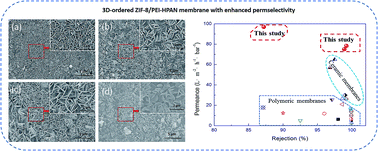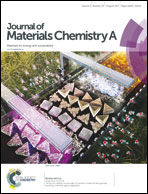Highly permeable zeolite imidazolate framework composite membranes fabricated via a chelation-assisted interfacial reaction†
Abstract
The preparation of high-permselectivity membranes is still a challenging task due to the limitations of conventional polymeric membranes. Herein, a chelation-assisted interfacial reaction (CAIR) was used to construct an MOF/polymer hybrid layer on a hydrolyzed polyacrylonitrile (HPAN) substrate to form a ZIF-8/PEI–HPAN composite membrane. Due to the strong chelating ability of polyethyleneimine (PEI) to metal ions, the formed ZIF-8/PEI selective layer showed high hydrophilicity and super wettability. Moreover, its surface morphology changed from a smooth structure to a ridge-and-valley structure via controlling the interfacial reaction conditions, leading to enhancement in the permeable area. As a result, the prepared ZIF-8/PEI–HPAN composite membrane exhibits a rejection of 99.2% for Congo red aqueous solution with a permeance of up to 78 L m−2 h−1 bar−1, which is 5–8 times that of the reported polymeric membranes with excellent dye rejection as well as good long-term stability. We anticipate that the CAIR method can be used as a potential strategy for the preparation of polymer-supported MOF membranes with both highly enhanced permeability and good retention.



 Please wait while we load your content...
Please wait while we load your content...